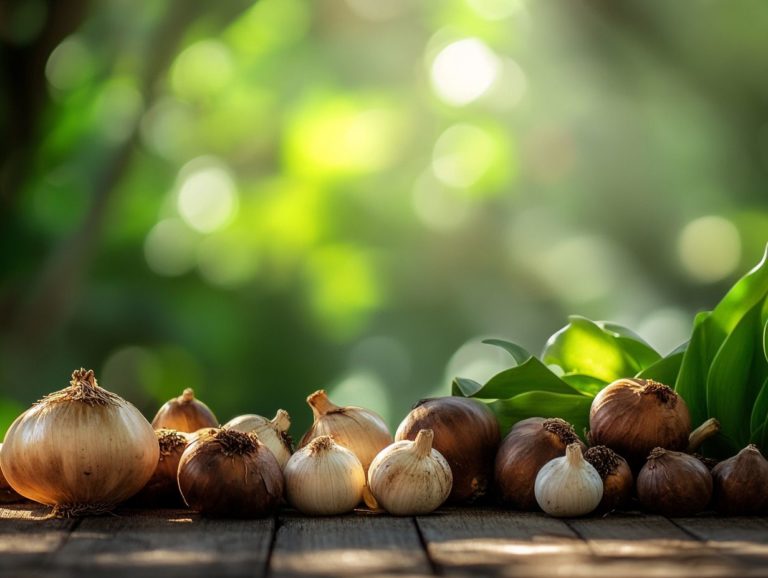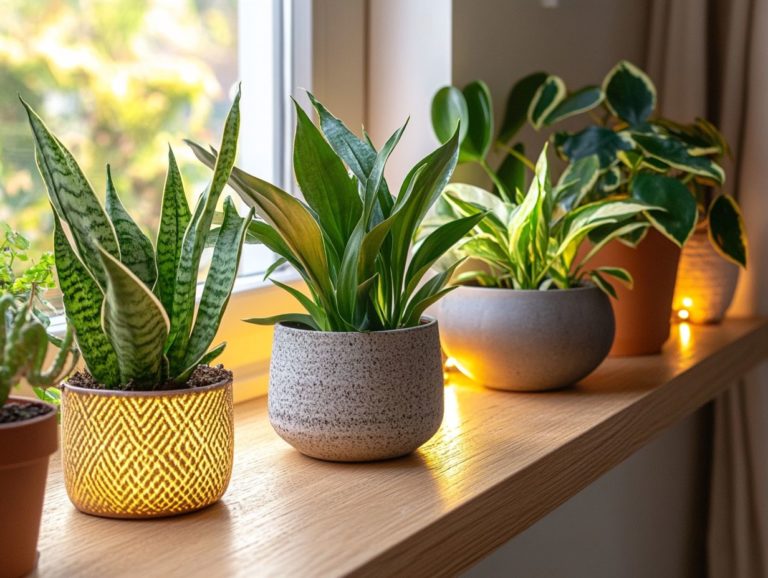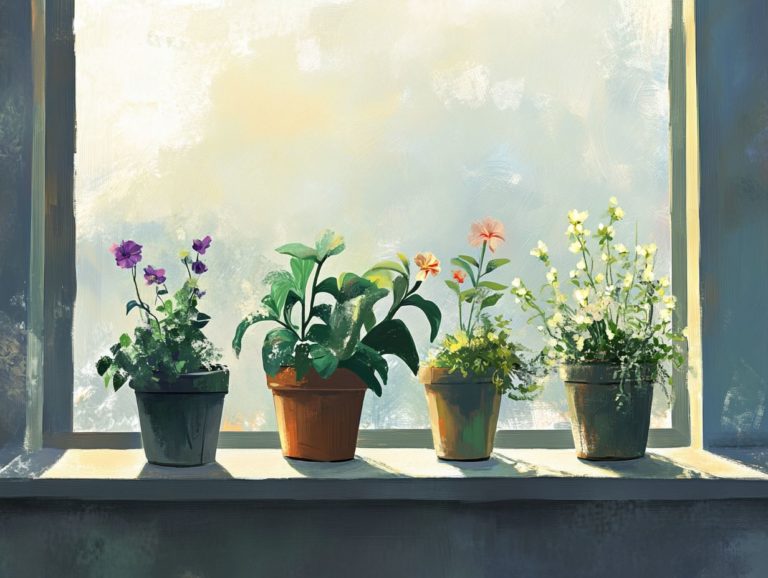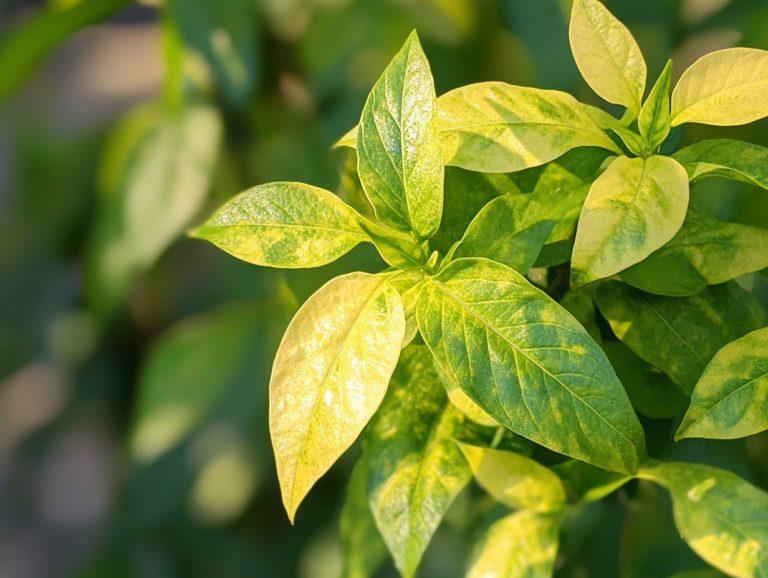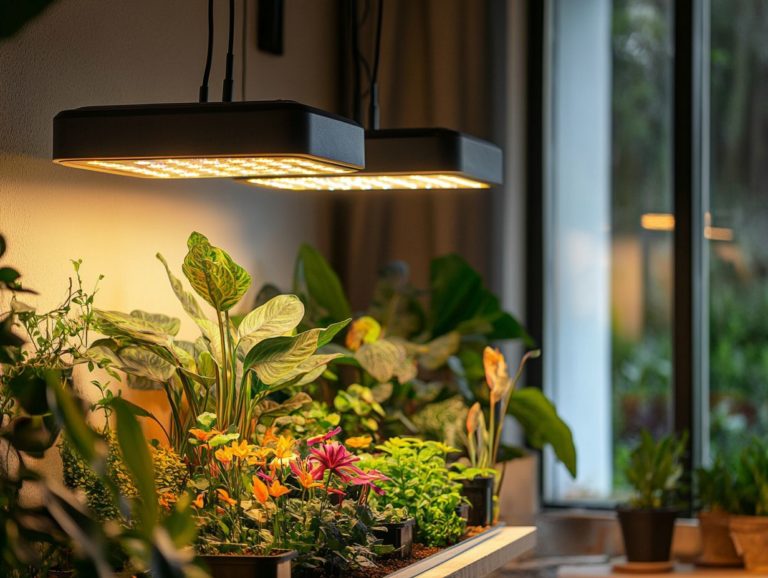Best Lighting Techniques for Indoor Gardening
When it comes to indoor gardening, the right lighting can truly transform the health and growth of your plants.
This guide delves into the most effective lighting techniques for nurturing your green oasis. It covers everything from selecting the ideal light sources to positioning them for maximum benefit using grow lights.
You ll discover the various types of lighting available, learn how to establish a proper schedule, and explore techniques for using reflectors to ensure optimal light distribution.
We ll discuss common pitfalls and offer insights into energy-efficient options.
Whether you re a seasoned gardener or just embarking on your indoor gardening journey, this article will empower you to cultivate thriving indoor plants!
Contents
- Key Takeaways:
- 1. Choosing the Right Lighting for Your Plants
- 2. Understanding the Different Types of Lighting
- 3. Positioning Your Lights Correctly
- 4. Using Reflectors to Maximize Light Distribution
- 5. Creating a Lighting Schedule for Your Plants
- 6. Maintaining and Replacing Your Lights
- 7. Supplementing Natural Light with Artificial Light
- 8. Avoiding Common Mistakes in Indoor Gardening Lighting
- 9. Incorporating Energy-Efficient Lighting Options
- 10. Experimenting with Different Lighting Techniques
- How Much Light Do Indoor Plants Need?
- What Are the Signs of Over or Under Lighting in Indoor Plants?
- How Can You Adjust Your Lighting Setup for Different Types of Plants?
- Frequently Asked Questions
- What are the best lighting techniques for indoor gardening?
- How does natural light affect indoor gardening?
- What is the difference between LED, fluorescent, and HID lights for indoor gardening?
- How do I determine the right lighting setup for my indoor garden?
- Why aren t regular household light bulbs suitable for indoor gardening?
- How long should I keep my indoor garden lights on?
Key Takeaways:

- Choosing the right lighting for your indoor plants is crucial for their growth and health.
- Understanding the different types of lighting available can help you determine the best option for your specific plants.
- Properly positioning your lights and using reflectors can ensure even distribution of light to all your plants.
1. Choosing the Right Lighting for Your Plants
Choosing the right lighting is vital for successful indoor gardening. This is especially true for houseplants and tropical species that flourish under ideal light conditions.
As the horticulture industry evolves, grasping the intricacies of light fixtures like LED and fluorescent bulbs can profoundly influence your plants success, particularly if you’re growing indoor edibles or blooming houseplants.
Full-spectrum grow lights, which mimic natural sunlight, are essential. Consider factors like light intensity, color temperature, and the specific growth needs of your plants.
For example, if you notice spindly seedlings, that s a clear indication they re craving abundant, bright light. In contrast, hardier succulents can thrive even in the dimmest corners of your home.
Experts like Megan Hughes stress the importance of evaluating the natural light patterns in your indoor environment. Joseph Tychonievich recommends using supplemental lighting to avoid stunted growth or lackluster flowering.
Think about positioning your light systems about 12 to 24 inches above your plants, and be ready to adjust as needed. Creating a consistent light schedule that mimics natural day-night cycles generally 12 to 16 hours of light can significantly boost growth. By understanding the distinct light preferences of your plants, you lay the groundwork for a flourishing indoor garden.
2. Understanding the Different Types of Lighting
Understanding the various types of lighting available for indoor gardening is essential for ensuring your plants receive the optimal light spectrum they require to thrive. Options like LED and fluorescent bulbs come with unique advantages and disadvantages that can significantly influence photosynthesis and nutrient absorption in your houseplants.
Choosing grow lights with specific modes can cater to the distinctive growth characteristics of your plants, enabling you to nurture everything from lush tropical varieties to indoor edibles like basil and parsley.
In terms of energy efficiency, these lighting options vary considerably; LEDs are the champions here, consuming less power and generating minimal heat, making them perfect for sensitive environments. Conversely, fluorescent lights might be easier on the wallet initially, but they could lead to higher electricity bills over time.
Regarding the light spectrum, LED lights typically offer a full range of wavelengths, which proves beneficial during flowering and fruiting stages. On the other hand, fluorescent lights emit a softer light that is ideal for leafy greens.
Considering these factors not only helps you select the right lighting for your indoor garden but also ensures that your diverse plant types receive the adequate conditions they need to flourish throughout their growth cycles.
Feel free to experiment with different lighting setups and watch your plants thrive!
3. Positioning Your Lights Correctly
Properly positioning your grow lights is essential for maximizing light exposure for your indoor plants; this can significantly influence their growth rate and overall health. Factors such as the distance from the plant, light intensity, and the type of light be it direct, indirect, or medium indirect play critical roles in how effectively your plants can photosynthesize and absorb nutrients. By understanding these elements, you can prevent issues like leggy houseplants and spindly seedlings, ensuring robust growth.
To achieve optimal light conditions, it’s vital for you to know the specific light requirements of each plant species. For instance, high-light plants typically need the fixtures positioned closer, while those in low-light environments may thrive with lights set farther away. Regularly monitoring conditions, whether with a light meter or simply using your hand to check warmth, can greatly inform any necessary adjustments.
As winter approaches and natural light begins to dwindle, increasing light levels artificially becomes crucial. Consider using timers to establish a consistent light schedule, which can further enhance growth during those shorter daylight hours.
4. Using Reflectors to Maximize Light Distribution
Using reflectors can significantly elevate light distribution in your indoor garden, ensuring that every plant, no matter its position, receives the illumination it needs for optimal growth. By strategically placing reflectors around your light fixtures, you can direct and maximize the efficacy of the light emitted by your grow light system, achieving more even coverage across all your houseplants. This technique is particularly advantageous for plants with varying light requirements, from lush tropical varieties to sun-hungry succulents.
Reflectors come in an array of materials, such as mylar, aluminum, and even white paint, each presenting unique benefits for light reflection. For example, aluminum is a popular choice due to its durability and impressive ability to reflect around 80% of light, making it an excellent option for larger setups.
To implement reflectors effectively, it s essential to understand your plants’ specific needs. Positioning a curved reflector above a low-light plant like a peace lily can enhance available light without overwhelming it. Meanwhile, pairing high-output LED lights with flat mylar panels can create an intense light source for sun-loving species like tomatoes or peppers, ensuring even the most light-demanding varieties thrive.
5. Creating a Lighting Schedule for Your Plants
Creating a lighting schedule for your indoor plants is essential, as it regulates their photoperiod and ensures they receive just the right amount of light for optimal growth. A thoughtfully designed light schedule, paired with proper watering and nutrient management, keeps your plants healthy and vibrant, fostering resilience against common issues like spindly seedlings or leggy houseplants. By tailoring light timings to meet the specific needs of your plants, you can achieve remarkable success in your indoor garden.
It’s crucial to sync your light schedules with natural day lengths, especially as the seasons shift and daylight hours fluctuate. For instance, as winter approaches, many plants benefit from extended light exposure to compensate for those shorter days. Different types of plants might require varying light durations; flowering species often thrive under longer photoperiods, while leafy greens can flourish with moderate light.
Understanding the intricate relationship between light duration, water intake, and nutrient absorption plays a significant role in your plants’ overall health, ensuring that your indoor garden thrives throughout the year.
6. Maintaining and Replacing Your Lights
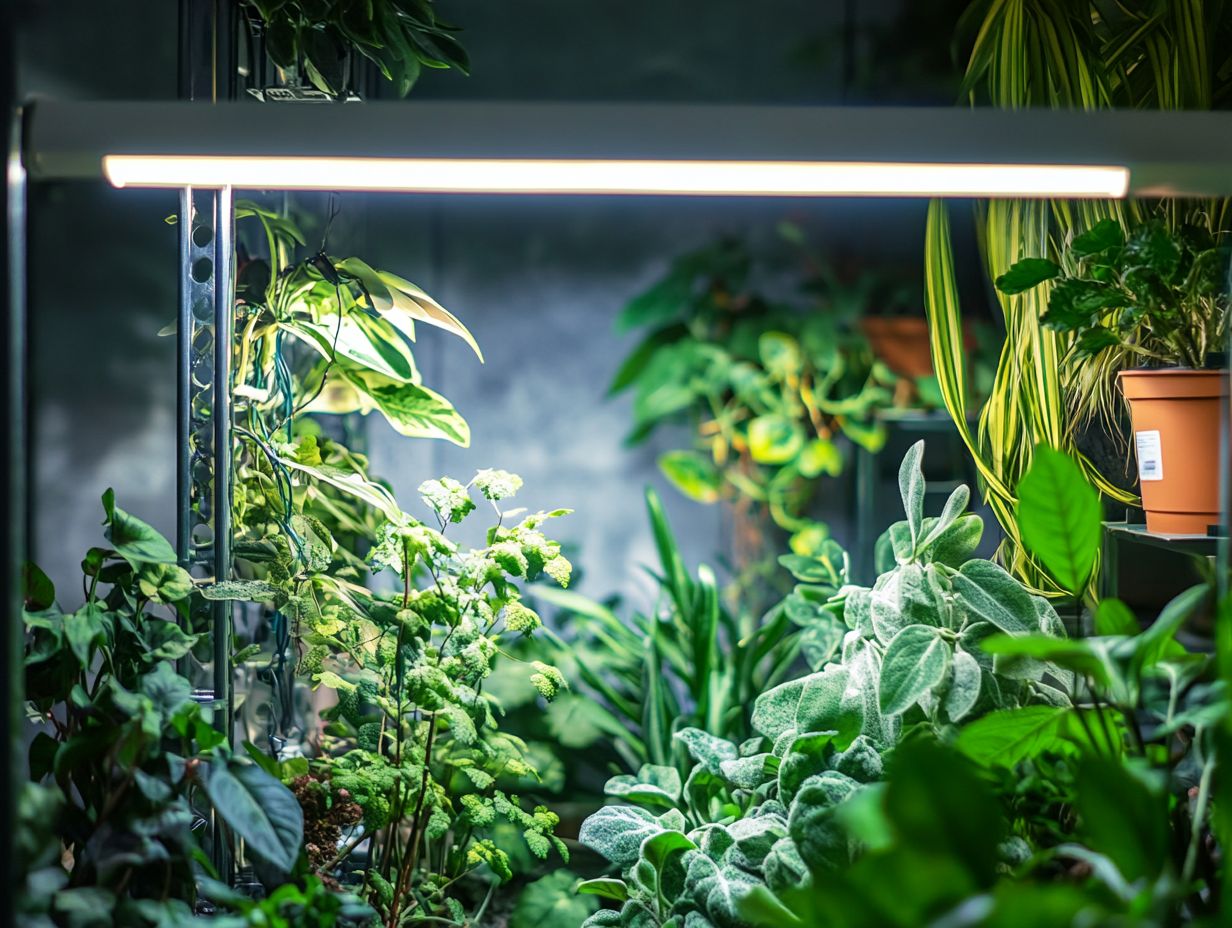
Maintaining and replacing your grow lights artificial lights designed to support plant growth, especially indoors is crucial for healthy plants. Consistent light intensity impacts their growth and overall health directly.
Establishing a regular maintenance schedule extends the life of your light fixtures and ensures your plants remain vibrant and thriving.
Routine checks for signs of wear, such as flickering, dim lighting, or discoloration, can signal inefficiencies. For optimal performance, replace fluorescent bulbs roughly every 12 months. LED bulbs typically last longer, needing replacement every 2-3 years.
Consider the specific needs of your houseplants, as some may require higher light intensity during their growth phase. Regular assessments are essential.
By keeping track of your bulbs’ performance, you’ll guarantee that all your plants receive the proper light spectrum, ultimately enhancing their ability to flourish.
7. Supplementing Natural Light with Artificial Light
Supplementing natural light with artificial lighting is essential for the health of your indoor plants, especially during gloomy winter months when sunshine seems to take a vacation. By thoughtfully incorporating grow lights into your indoor garden setup, you can ensure your plants receive the light intensity necessary for photosynthesis, the process plants use to make food from light, fostering robust growth and lush foliage.
Mastering the art of blending natural and artificial light will elevate your indoor gardening game, allowing you to cultivate a thriving oasis year-round. To achieve this, consider exploring the best light arrangements for houseplants.
Assessing the specific light requirements of each plant species is crucial, as some will thrive with more exposure than others. For example, succulents and cacti bask in bright light, making them perfect candidates for supplemental fixtures. On the other hand, leafy greens like spinach and lettuce appreciate adjustable lighting to meet their moderate light needs. To effectively grow these plants indoors, check out how to use light for indoor vegetable gardens.
During winter months, utilizing a combination of LED grow lights and fluorescent fixtures can effectively mimic the spectrum of natural sunlight. Timers can automate light exposure, ensuring consistent lighting for your green companions. Additionally, using light shades for indoor plants can enhance growth, perfectly complementing the natural light that streams through your windows.
8. Avoiding Common Mistakes in Indoor Gardening Lighting
Avoiding common mistakes in indoor gardening lighting is essential for the success of your plants. Missteps can lead to issues like leggy houseplants and spindly seedlings. Many gardeners may underestimate the importance of light conditions; intensity and duration can significantly impact plant growth and health. By recognizing and correcting these errors, you can create a vibrant indoor environment for your houseplants!
For instance, positioning lights too far from the plants can lead to insufficient light exposure, resulting in growth deficiencies. Conversely, using lights that are too intense can scorch delicate leaves, causing irreversible damage.
Understanding your specific plants’ needs is fundamental; some thrive in low light while others crave bright, direct sun. To rectify these common oversights, consider employing adjustable LED lights. This flexibility allows you to fine-tune light placement and intensity according to the evolving needs of your green companions, and for more guidance, check out these tips for effective plant lighting.
Keeping an eye on the duration of light exposure is crucial typically, 12 to 16 hours for most houseplants. This mimics their natural environment and promotes robust growth, helping you cultivate an indoor oasis that thrives.
9. Incorporating Energy-Efficient Lighting Options
Incorporating energy-efficient lighting options isn t just a nod to the environment; it s also a smart way to cut down on electricity costs while giving your plants the ideal light they need to thrive. Options like LED and fluorescent bulbs allow you to create effective lighting solutions that promote healthy plant growth without burning a hole in your wallet. Understanding these choices helps you adopt a more sustainable approach to indoor gardening.
When you choose these technologies, you ll see significant cost savings over time. For example, LEDs consume up to 75% less energy than traditional incandescent bulbs and last much longer, giving you the benefit of fewer replacements. The reduced carbon footprint shows the environmental benefits, aligning perfectly with a more eco-conscious lifestyle.
To maximize the benefits of these energy-efficient lights, position them strategically at various angles and heights to ensure even illumination for all your plants. Incorporating light management for indoor orchids can further optimize light exposure, enhancing the efficiency of your setup while nurturing a thriving environment for your greenery.
10. Experimenting with Different Lighting Techniques
Have you ever wondered how different lighting affects your plant s growth? Experimenting with various lighting techniques can help you tailor your indoor gardening setup to meet your plants’ specific needs. By testing light systems, like full-spectrum (light that mimics natural sunlight) and colored light options, you ll see how plants from orchids to African violets respond to changes in their environment. This hands-on approach helps you understand what plants need and boosts your garden’s success.
To truly maximize these observations, document your experiments. Keep track of the outcomes associated with each light variation you explore. For instance, try different intensities such as low, medium, and high light settings, and use colored filters to see how they influence growth rates and overall plant health.
This process will yield valuable insights into which lighting conditions suit specific plant varieties. You might even discover benefits like increased blooming frequency or improved leaf development. Customizing your lighting strategies to cater to particular plants, such as following these lighting tips for indoor herb gardens, can lead to a more vibrant and flourishing indoor garden.
How Much Light Do Indoor Plants Need?
Understanding how much light your indoor plants need is essential for their growth, as it directly affects their ability to photosynthesize and absorb vital nutrients. Different species have unique light requirements, from low-light plants like succulents to high-light enthusiasts such as tropical varieties. By adjusting your light exposure to meet these needs, you can create an amazing environment for thriving houseplants!
To effectively assess the light your plants receive, observe the different areas of your home throughout the day. North-facing windows typically provide the least light, making them ideal for shade-loving varieties. In contrast, south-facing windows deliver bright, direct sunlight perfect for sun-loving species.
Consider using sheer curtains to soften strong rays and create a balanced atmosphere for your indoor garden. If natural light is limited, grow lights are an excellent alternative, allowing you to customize light levels to suit your plants’ needs. For more information on using sunlight for indoor plants effectively, proper placement and rotation of your plants can ensure even exposure, promoting robust and healthy growth.
What Are the Benefits of Using Artificial Lighting for Indoor Gardening?
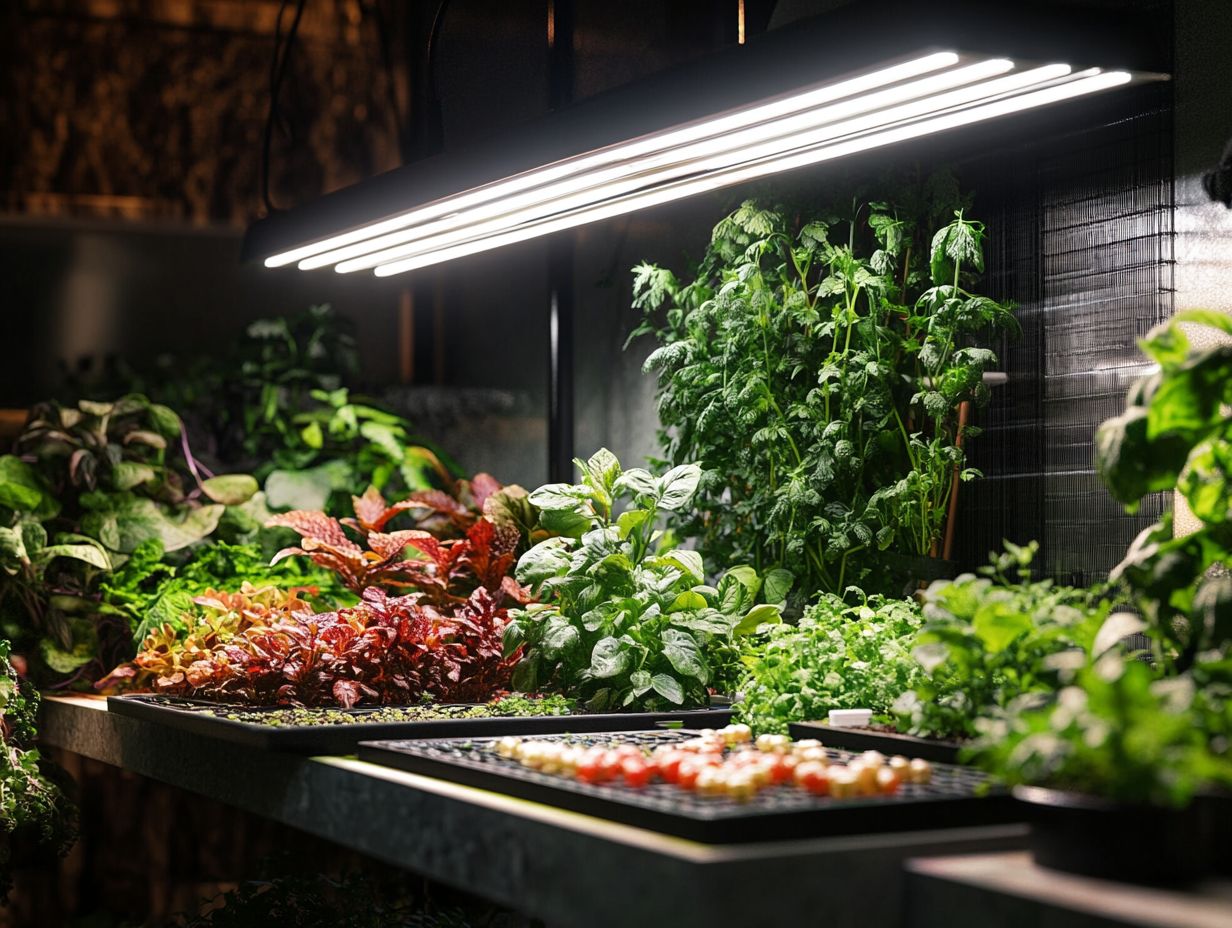
Discover the amazing benefits of artificial lighting for your indoor garden! You ll be amazed at how your plants can thrive. Using artificial lighting for indoor gardening presents a plethora of advantages, significantly boosting plant growth and health, particularly in spaces where natural light falls short.
By mimicking sunlight with effective lighting systems, you can ensure your plants receive the right light needed for healthy plant growth. Consider exploring lighting considerations for plant growth to achieve healthier, more vibrant houseplants that can thrive year-round, no matter the external lighting conditions.
Controlling light intensity and duration is important for shaping your plants’ growth cycles. With adjustable settings, you can simulate a variety of daylight conditions that reflect the natural progression of the seasons.
By fine-tuning these elements, you can speed up growth and enhance resilience against pests and diseases. The ability to modify the light spectrum allows for customized nutrient absorption, ultimately boosting overall plant vitality.
This controlled environment opens the door to a diverse array of plant varieties, transforming indoor gardening into a versatile and rewarding endeavor.
What Are the Different Types of Artificial Lighting for Indoor Gardening?
There are various types of artificial lighting available for indoor gardening, each bringing its own set of benefits tailored to the needs of your plants. Options like LED, fluorescent, and specialized grow lights can make all the difference.
Understanding the nuances between these choices is crucial for selecting the right system that meets the diverse lighting requirements of your houseplants, whether they re tropical beauties or vibrant flowering species. This knowledge gives you the power to create an optimal environment where your plants can truly thrive.
Take LED lights, for instance. They are renowned for their energy efficiency and impressive lifespan, making them a cost-effective choice in the long run, even if the initial investment is a bit higher.
On the flip side, fluorescent lights are budget-friendly and provide a suitable spectrum for leafy greens, though they might not pack the intensity needed for flowering plants.
Then there are specialized grow lights, engineered to emit specific wavelengths that are beneficial for photosynthesis, but their higher energy consumption might give some plant enthusiasts pause.
By carefully assessing the light needs of your different plant types, you can select the perfect lighting solution that enhances growth and flowering while aligning with your budget and energy efficiency goals.
How Can You Tell If Your Plants Are Receiving Enough Light?
Determining whether your plants are receiving adequate light involves observing several key indicators, including their growth characteristics and overall health. The right light is crucial for growth; you’ll notice robust foliage, vibrant colors, and strong stems, all essential for healthy indoor plants.
Conversely, if they re not getting enough light, you might spot signs of stress, such as yellowing leaves or elongated stems. Recognizing these cues helps you fine-tune your lighting setup, especially when considering light systems for optimal plant health.
Leaf drop and slow growth are significant indicators that your plant might be craving more natural or artificial light. By keeping a close eye on these signs, you ll gain a clearer understanding of your indoor garden s requirements.
To create a thriving environment, consider using adjustable grow lights or LED bulbs or moving your plants closer to windows to maximize photosynthesis during peak sunlight hours.
Don t forget to rotate your plants occasionally; this ensures they receive uniform light exposure. Adapting your approach with the changing seasons will further support their growth and keep your indoor garden flourishing.
What Are the Signs of Over or Under Lighting in Indoor Plants?
Recognizing the signs of over or under lighting in your indoor plants is essential for maintaining their health. Promoting optimal growth requires an understanding of types of light. If you notice symptoms like leaf scorch, particularly in tropical plants, and browning, which can also affect leggy houseplants, that s a telltale sign of overexposure to light.
On the flip side, if your seedlings look spindly, it s often a sign of insufficient light. Additionally, growth rates are sluggish due to inadequate brightness, indicating they re not getting enough light. Paying close attention to these factors is crucial for any gardener wanting to create a thriving environment.
When plants are overexposed to harsh lighting, leaves may curl, especially if the light source is too close, or they may drop prematurely, affecting spring transplants, signaling distress. Conversely, insufficient light can lead to yellowing foliage, nutrient deficiency, and lackluster flowering in orchids and certain African violet species that thrive under brighter conditions.
To address these issues effectively, evaluate your plants, including cacti and succulents, based on their specific light requirements. Don t hesitate to employ a light meter if needed.
Once you ve diagnosed the problem, you can easily make adjustments by repositioning your plants closer to light sources or using grow lights on timers. This ensures they receive the adequate exposure they need, ultimately fostering a healthier indoor garden environment.
How Can You Adjust Your Lighting Setup for Different Types of Plants?
Adjusting your lighting setup for different types of plants is vital for cultivating a thriving indoor garden. Each species has its unique light requirements. You need to consider factors like distance from the light source, which is critical for plant success, and the specific light spectrum essential for optimal growth to ensure every plant gets the conditions it needs to flourish.
Take high-light tropical plants, for example. They thrive on direct sunlight, which is ideal for high-light tropical plants like basil. They will truly flourish when you position full-spectrum LED panels close to their leaves to maximize energy absorption. To better understand how to meet their specific needs, learn about understanding indoor plant light needs. Low-light succulents, on the other hand, prefer softer, indirect lighting, which aligns more with their needs.
Using adjustable fixtures, such as pendant lights or grow lights on flexible mounts, allows you to customize light intensity and positioning effortlessly. Don’t forget to rotate your plants regularly to ensure they receive uniform light exposure. For those looking to enhance their indoor garden, consider the top indoor plants for varied lighting. This little trick promotes balanced growth and keeps your garden looking vibrant.
By understanding each plant’s specific needs, you empower yourself to create an effective lighting regimen, especially during the winter months, that nurtures your indoor flora to its fullest potential.
Frequently Asked Questions
What are the best lighting techniques for indoor gardening?

The best lighting techniques for indoor gardening depend on the type of plants being grown and the amount of natural light available in the space. Some popular options include using LED grow lights, fluorescent lights, and high-intensity discharge (HID) lights. These can be beneficial for successful gardening.
How does natural light affect indoor gardening?
Natural light is a crucial factor in indoor gardening as it provides the necessary energy for plants to grow and thrive. However, not all plants require the same amount of natural light, and some may even be negatively affected by too much direct sunlight.
What is the difference between LED, fluorescent, and HID lights for indoor gardening?
Understanding the different types of lights can make your indoor garden thrive! LED lights and fluorescent bulbs are popular because they are energy-efficient and provide a full spectrum of light for plant growth.
Fluorescent lights are also energy-efficient but may not deliver the same intensity as LEDs. In contrast, HID lights produce intense light and a lot of heat, making them ideal for larger indoor gardens.
How do I determine the right lighting setup for my indoor garden?
Finding the right lighting setup starts with understanding your plants light needs. Consult a professional gardener or use a light meter to measure the light intensity in your space.
Why aren t regular household light bulbs suitable for indoor gardening?
Regular household light bulbs provide some light, but they aren t ideal for long-term use. They lack the intensity needed for optimal plant growth.
How long should I keep my indoor garden lights on?
The duration your lights stay on depends on the type of plants you are growing. Most need about 12 to 18 hours of light each day.
Research your specific plants to adjust their light exposure accordingly.

